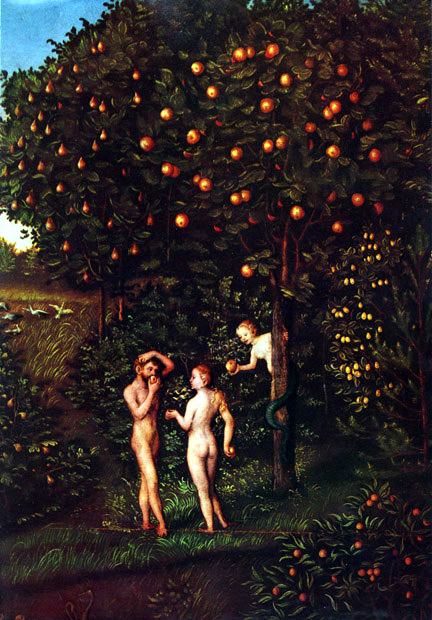I: Introduction
Genesis, or Bereshith (“In the beginning”) in the original Hebrew, is the first of the five books (Pentateuch) traditionally ascribed to Moses, the Torah. It’s actually the product of several writers and editors who, over the course of hundreds of years, gave it its final form. According to the persuasive documentary hypothesis, four stylistically distinct narrative strands can be found interwoven throughout the Tanakh (Torah, Nevi’im, and Ketuvim–the Law, Prophets, and Writings), or the Old Testament, as Christians call it.
Those four narrative strands are, in approximate historical order, the Elohist, Yahwist (or Jahwist), Deuteronomist, and Priestly sources (E, J, D, and P). In the Yahwist source, God is referred to as YHWH (Yahweh, the Tetragram, translated as the LORD); the Elohist source calls God Elohim (“God,” or “gods,” depending on the context); the Deuteronomist source (“second law”) is to some extent a retelling of much of the law; and the Priestly source, predictably, serves the agenda of the ancient priests, and also has a more developed theology.

I’ll be examining the first eleven chapters of Genesis, known as the ‘primeval history.’
II: The Yahwist Adam and Eve Narrative
I will start with the Yahwist account of the Adam and Eve story, because its presentation of YHWH Elohim is much more primitive than the transcendental, spiritual depiction of Elohim as given in the Priestly account of the Creation. Indeed, the Yahwist God is both physically and mentally anthropomorphic, walking in the Garden of Eden in the cool of the day (Genesis 3:8); He’s also fallible and of limited knowledge, creating all the other animals as prospective companions for Adam before realizing that Eve is truly fitting for him (Genesis 2:18-22). He also needs to ask Adam where he is (3:9), who told him he was naked, and if he ate of the forbidden fruit (3:11), all needless questions for an omniscient God.
YHWH, after creating the Garden of Eden, made Adam out of the dirt (‘adamah, traditionally translated “dust,” Genesis 2:7) of the earth. Later, when YHWH tells Adam he will die for having eaten of the Tree of Knowledge, He says, “Dust (‘adamah) you are, to dust you shall return.” (Genesis 3:19) Since Adam’s opposite sex companion has the name of Eve (hawwah, “life”), his equation with the dirt, where all the dead return, thus associates him with death. Opposite sexes represent opposite principles: for the ancients, woman is life; man is death.
The whole reason Adam was created (Genesis 2:5) was to till the garden (Genesis 2:15); in other words, man exists to work. Eve, as the “mother of all living,” was given life in order to give life herself: a great honour, but also a great burden. For the ancients, woman is; man does.
It isn’t my wish to defend these traditional roles and ancient attitudes; on the contrary, I comment on them to critique them, for I’m doing a critical analysis of Genesis to expose its authoritarian aspects. People shouldn’t be compartmentalized into roles, with a few at the top and most at the bottom. I’ll discuss more of that later.

Some have interpreted Adam as being a hermaphrodite prior to the creation of Eve. The removing of a rib from Adam during his sleep thus means that the rib symbolizes the feminine aspect removed from the primordial human being, thus creating separate sexes. Creation by separation is also seen in the Priestly account of the creation: heaven/earth, light/darkness, day/night, water/land, etc. More on that later.
All of this separation into distinct parts is seen as good according to the Biblical writers. I will be arguing the opposite opinion, since separation is used to justify discrimination, authoritarianism, and divisiveness–again, more on that later.
Adam and Eve were naked (‘arummim) and not ashamed, “naked” also implying vulnerable, helpless. Their unashamed, natural state also implies the naïve, innocent way of children, who don’t know much of anything. That the serpent is more subtle (‘arum), cleverer than any other animal, implies a special knowledge.
Thus we see a dialectical relationship between the words in the Hebrew pun, ‘arummim and ‘arum. There is a sweetness in the childlike innocence of allowing one’s secrets (symbolized by the would-be exhibitionism of showing one’s ‘private’ parts) to be known, and a wickedness in being clever, cunning; but there’s also a danger in that vulnerable innocence, and an advantage in having a knowledge that leads to cleverness, shrewdness (see also p. 14, HEBREW BIBLE, notes to Genesis 2:24-25, and 3:1-21). The good of one phases into the evil of the other, and vice versa, like the dialectical unity of opposites as can be symbolized by the tail-biting head of the ouroboros, another serpent I’ve discussed elsewhere.
The serpent tempts Eve by telling her that in eating of the Tree of Knowledge, she and Adam will be like God, or gods, depending on the translation of Elohim, to have the power of knowledge. Since Yahweh has forbidden eating of this tree, on pain of death, one must ask what’s wrong with acquiring knowledge.
Is this an allegorical illustration of how knowledge results in a sad loss of innocence? That’s one valid interpretation. Is this act of disobedience to God symbolic of carnal knowledge, the sex act, resulting in concupiscence? Or is eating the forbidden fruit an act of rebellion against our ‘loving’ Lord, who doesn’t want us to have the power that knowledge gives? Or do freedom and knowledge lead to isolation and fear?
III: From Freedom to Fear
In Escape From Freedom, Erich Fromm describes how Protestantism gave freedom from the authoritarian Catholic Church, but then left a vacuum of insecurity for Christians like Luther and Calvin, who resolved this problem with a far more authoritarian rigidity: “…while Luther freed people from the authority of the Church, he made them submit to a much more tyrannical authority, that of a God who insisted on complete submission of man and annihilation of the individual self as the essential condition to his salvation. Luther’s “faith” was the conviction of being loved upon the condition of surrender…” (Fromm, page 81, his emphasis)
Similarly of Calvin, Fromm writes, “Although he too opposes the authority of the Church and the blind acceptance of its doctrines, religion for him is rooted in the powerlessness of man; self-humiliation and the destruction of human pride are the Leitmotiv of his whole thinking.” (Fromm, page 84)
The Protestants, as we can see, were the authoritarian heirs of the priests, be they ancient Hebrew or Catholic. Again, instead of allowing the flock to seek knowledge, men like Luther and Calvin wanted the flock to submit to their authority, to see themselves as “naked” and helpless without that authority.

IV: Blame and Punishment
Back to Genesis, where Eve gives Adam the forbidden fruit. Many traditionalists have done a misogynistic spin on this story, blaming Eve unfairly for the Fall, when the text itself clearly shows Yahweh judging and punishing the serpent, Eve, and Adam for the role each plays in the Fall.
John Milton, in Paradise Lost, took pains to soften the blame put on Eve, instead praising her beauty in virtue, in Book IX, lines 896-899: “O fairest of all creation, last and best/Of all God’s works, creature in whom excelled/Whatever can to sight or thought be formed,/Holy, divine, good, amiable or sweet!”
Instead of being tempted by her, Milton’s Adam freely chooses to fall with her, out of love: “Matter of scorn, not to be given the foe,/However I with thee have fixed my lot,/Certain to undergo like doom, if death/Consort with thee, death is to me as life;/So forcible within my heart I feel/The bond of nature draw me to my own,/My own in thee, for what thou art is mine;/Our state cannot be severed, we are one,/One flesh; to lose thee were to lose my self./So Adam, and thus Eve to him replied./O glorious trial of exceeding love,/Illustrious evidence, example high!” (IX, 951-962)
Now Milton was no proto-feminist, of course: he took the traditional patriarchal line that man is “the head of the other sex which was made for him; whom therefore though he ought not to injure,…” (The Doctrine and Discipline of Divorce Restored to the Good of Both Sexes, page 223); but his kinder attitude towards Eve shows that the misogynist interpretation of her having tempted Adam was far from, and needn’t have been, universal.

The Tree of Knowledge of Good and Evil isn’t merely about knowing right from wrong: “good and evil” is a Hebrew merism meant to represent all aspects of knowledge, i.e., from ‘the worst’ to ‘the best.’ Knowing right from wrong is perfectly defensible from a moral standpoint; if Yahweh is a moral God, He should be all in support of allowing Adam and Eve to have such knowledge. No: He’s opposed to Adam and Eve gaining the power of knowledge, for such an acquiring of power would be a threat to His power.
The Christian notion of Adam and Eve being morally perfect before the Fall is illogical, as I described elsewhere: if they were originally without moral faults, they would never have chosen to disobey God. Milton’s rhetorical notion that they were “Sufficient to have stood, though free to fall” (III, 99) misses the point. Being “free” to sin alone doesn’t make a morally perfect person want to sin; his perfect morality will make it clear to him that sinning will bring about his destruction, no matter how tempting the act is, and no matter how free he is to commit the sin.
It would make more sense to regard the two naked lovers’ fall from grace in a dialectical fashion, that is, in trying to rise too high in the gaining of knowledge, to become clever (‘arum), they become knowledgeable only of their own nakedness (their being ‘arummim), of their vulnerability and helplessness, a falling to the lowest point. The ascent to the biting head of the ouroboros (powerful knowledge and being ‘arum), going past that point, and phasing into the serpent’s bitten tail of their naked (‘arummim) powerlessness. (Recall how I see the ouroboros as a symbol for a circular continuum.)

Speaking of serpents, they were revered as symbols of rebirth, fertility, wisdom, and knowledge prior to the polemical pages of Genesis; thanks to YHWH’s punishment of the serpent for tempting Eve, it is now one of the most despised of animals, the hostility especially being between it and her (Genesis 3:14-15). Gaining knowledge is morally wrong, apparently.
Note the wording of Eve’s punishment, with respect to her relationship with Adam: “thy desire shall be to thy husband, and he shall rule over thee.” In the New English Bible, this passage is rendered, “You shall be eager [or feel an urge] for your husband,” suggesting perhaps an emotional dependence, or a neediness, leading to his dominance in the family. I suspect the writers were manipulating women’s empathy and love, taking advantage of it, for the sake of reinforcing and justifying the patriarchal family.
Finally, Adam’s punishment: the difficulty and hardship of working in order to survive. I don’t mean to belittle or trivialize the toil that women also endure, especially today, to support their families–far from it; but we shouldn’t assume that the male role as traditional breadwinner is in any way glamorous, or a privilege. Part of ensuring equality for women will include no longer exploiting their “desire,” “urge,” or eagerness for their husbands (if they choose to have them); part of equality will also include eliminating compulsory sex roles, so both sexes can, to an equal extent, be free to be both providers and homemakers.
V: The Birth of Death
Then, while of course both Adam and Eve (and the serpent, for that matter) will eventually die–not the death of their innocence, which has already happened the day they ate the forbidden fruit, but actual, physical death–the death sentence is explicitly said by YHWH to Adam (Genesis 3:17-19). I suspect that this narrative is a mythical distortion, as so many ancient Greek, Roman, and Middle Eastern narratives are (read Frazer‘s Golden Bough to see what I mean), of an ancient rite of human sacrifice, the killing of the old sacred king by the new one (many examples of such mythical distortions of such rites can also be found in Graves‘s two-volume Greek Myths).
To understand what I mean by the myth distorting the original ritual, as opposed to just plain describing what happened, we need to consider how language in the ancient world expressed history and fact in a poetic, metaphorical way, as opposed to the modern descriptive, prosaic way. Northrop Frye elaborates: “The first phase of language…is inherently poetic: it is contemporary with a stage of society in which the main source of culturally inherited knowledge is the poet, as Homer was for Greek culture…There were technical reasons for this: verse, with its formulaic sound-schemes, is the easiest vehicle for an oral culture in which memory, or the keeping alive of tradition, is of primary importance…the ability to record [i.e., writing it down] has a lot more to do with forgetting than with remembering: with keeping the past in the past, instead of continuously recreating it in the present.” (Frye, page 22)

Frye continues: “The origins of the Bible are in the first metaphorical phase of language, but much of the Bible is contemporary with the second-phase separation of the dialectical from the poetic, as its metonymic “God” in particular indicates. Its poetic use of language obviously does not confine it to the literary category, but it never falls wholly into the conventions of the second phase.” (Frye, page 27)
So what we get in such characters as Yahweh, Adam, and Eve (as in so many of the other characters in myths of many other cultures of the ancient Middle East) is an alteration by metaphor and symbol of what originally happened in history, a result of the oral passing on of the story before it was finally written down. I don’t mean to show a dogmatic allegiance to the very fallible writing of Graves, Frazer, and the other Cambridge ritualists, for indeed, their ideas are far from universally applicable (and Graves’s ‘scholarship’ is particularly mischievous, to put it as kindly as possible); but I do think their ideas can be applied to these specific mythical narratives, as certain motifs seem to reappear here and there, and thus at least seem to show recognizable patterns.
In my speculation, Adam would have been the old king, engaging in an orgy with Eve (the queen) to promote fertility. The sexual symbolism of the two naked lovers eating forbidden fruit would suffice as the remnants of the original orgy, now mythically distorted (any other participants in the orgy having already been excised from the story). Finally, the new king (now YHWH) walks in the garden in the cool of the day, and kills the old king, something mythically distorted into a mere death sentence.
Another aspect of the rite of human sacrifice that seems to have been distorted and incorporated into the Adam and Eve narrative is the scapegoating and banishing of the one, or ones, who committed the sacrificial murder. I emphasize here that the narrative, as we have it, has distorted what originally happened, since those killed in the sacrifice also double as those banished, namely Adam and Eve.

The killer in the original sacrifice, represented here by Yahweh Elohim, could also, in a way, be the banished one, since His separation from humanity (because of the original sin of Adam and Eve) could be seen as yet another mythical distortion of the consequences of the rite of human sacrifice.
The story of King Oedipus serves as another example of the mythical distortion of the ancient rite of human sacrifice: Oedipus is the new king who murders the old sacred king (distorted into his father, King Laius), marries the queen (distorted into his mother, Iocaste), and incestuously enters her bed (a distortion of the orgia, or fertility rite). He leaves Thebes with his daughter/sister Antigone, a mythical distortion of the scapegoat who is banished from the city to expiate for the sins of the people of that city.
Cain’s murder of Abel, while on one level representing the shift from a hunter-gatherer society to an agricultural one, may also be a distortion based on a rite of human sacrifice, for the sake of founding a new city. For when Cain was banished by God and settled in Nod, to the East of Eden, he founded a city named after his son, Enoch. The Romulus and Remus myth (the former having killed the latter) also seems to be based on a rite of human sacrifice to found a city–Rome, of course. See Hyam Maccoby‘s book, The Sacred Executioner, for more details.
VI: The Sons of God
The opening of Genesis, chapter six, is fascinating. It reads like something straight out of pagan myth; know that the ancient Hebrews started with polytheism like everyone else in that part of the world, then shifted to monolatry (a belief in many gods, but commanded to worship only YHWH, their tribal deity), then finally to monotheism, as expressed in the transcendental, spiritual God of chapter one, from the Priestly narrative). The use of b’nei ha-Elohim (sons of God, or sons of the gods?) reflects this transition.
Whether they’re the sons of God, or of the gods, ultimately doesn’t matter: they’re clearly divine or semi-divine beings (angels? That they’re the descendants of Seth seems to me like a Church cover-up of the obvious paganism.) who have come down from the heavens to make love with “the daughters of men,” resulting in the partially divine Nephilim, giants, great heroes of renown. It reads like Zeus seducing pretty maidens, resulting in men like Heracles! Here we see an example of the Biblical transformation of pagan myth.
The whole p0int, however, of this sexual union of the “sons of God” with the “daughters of men,” leading to the explosion of sin in the world, and in turn leading to the Great Flood, is that according to Biblical morality, you gotta keep ’em separated–namely, the divine and human worlds. An intermixing of the elements separated in the Creation results in chaos, the literal Chaos of the primordial world before the Creation (Mays, pages 88-89).

VII: Creation From Chaos
Orthodox Christians insist that God created the universe ex nihilo, but this isn’t borne out in the first chapter of Genesis. When Elohim created “the heaven and the earth” (another merism, here meaning everything, the universe; but with the implied dualism of a separation of above from below, since people in the ancient world viewed the universe as a layer of heaven over a flat Earth, with the layer of Hades at the bottom), everything “was waste and void,” primordial Chaos, an infinite ocean, if you will, of formless, undifferentiated matter.
Milton–one of the best-read of English poets, and a polyglot who knew Italian, Greek, Hebrew, etc.–believed the heresy that God created the universe not ex nihilo, but out of primordial Chaos. Some of his belief may have been influenced by his reading of the Greek myths in their classical sources; but some of it must have been influenced by his understanding of the nuances of the original Hebrew, tohu wa-bohu.
So the ruach of this transcendental God (not the physical, man-like Yahweh who walked in the garden in the cool of the day and asked questions He didn’t know the answers to) moved upon the face of the waters, the waters of a Brahman-like oneness of undifferentiated matter. The “earth” (Genesis 1:2) wasn’t earth as such, since the land wasn’t yet formed by its separation from the oceans, the waters above hadn’t yet been separated from those below, and not even the light was yet formed by its separation from the darkness (choshek, which translated from the Hebrew is darkness, or confusion, this latter being an intermixing), no difference between day and night.

Everything was just a watery, dark oneness, similar to the Hindu speculations in the Rig Veda, 10.129. Creation in this Priestly narrative is all about separating things into dualistic opposites: first, light and darkness, creating day and night (without the sun!); then, the firmament separates waters above from the oceans below (remember, heaven is a layer above, and the Earth is a flat layer under it, according to the ancients), the second day; and the separation of the oceans from the land, the third day.
Paralleling the first three days, the next three days involve the creation of the sun for the day, and the moon and stars for the night, the fourth day; the creation of animals flying in the firmament versus the sea animals, the fifth day thus corresponding to the second; and on the sixth day, the creation of the land animals, and finally, ha-‘adam, male and female (implying a hermaphroditism that will be separated into sexes later), made in the image of Elohim. (Is “He” androgynous, too? That is, though Elohim has the masculine plural ending of -im, since the masculine is traditionally used as a generic form for both sexes, could the meaning “gods” imply the inclusion of goddesses, too?)
VIII: Separation is Saintly
God looked at his creation, everything separated into opposites, just as the Priestly writers wanted it, and He saw that it was tov, good. (Incidentally, the separation of every living thing after its kind has been used to justify racial segregation.) It is only the intermixing of these opposites, reunifying them, that is considered sinful. Hence the sin of Adam and Eve becoming like gods–“one of us,” God says to the angels (Genesis 3:22), who were once inferior gods in the heavenly, divine council of pagan times–by acquiring the power to know, yada, which also has a sexual connotation, the uniting of male and female, hence the interpretation that the naked couple’s sin was a sexual one.
Cain’s murder of Abel is sinful also because only the divine world has the right to decide when one may die; his killing of his brother thus shows him arrogating himself to a divine status, another forbidden mixing of above and below.
The plan to build the Tower of Babel, meant to reach up to heaven and so connect above with below, is once again an attempt to mix the divine world with the human one. Hence, God says to the heavenly host, “let us go down, and there confound their language,” (Genesis 11:7) making a babble of mutually incomprehensible languages.

IX: The Flood as Creation 2.0
So, to return to the deluge story, the divine beings above, making love with the women of earth is another forbidden mixture of opposites, resulting in a grotesque proliferation of sin that causes God to regret His creation of the world. The Great Flood is thus a return to the endless seas of Chaos before the Creation.
The end of the forty days and nights of rain (or is it 150 days and nights, according to the Priestly source?) parallels the Creation’s second-day separation of the waters above and below with the firmament. The slow receding of the waters after the flood parallels the separation of land and ocean on the third day of Creation. Noah’s sending of the raven and the dove to know if the waters have abated parallels the fifth day’s creation of birds. Noah’s family emerging from the ark, with all the pairs of animals, parallels the sixth day. Separations are re-established, all is well again, and God puts His rainbow in the sky. Noah’s sacrifice to God at an altar exemplifies a holy moment corresponding to the holy seventh day that God blessed and rested on.
But just as there was naked wickedness of a sexual sort in the Garden of Eden, so is there in Noah’s tent, in which he gets naked and drunk from the wine he’s made from the vineyard he planted. What does it mean when his son, Ham, sees him naked in the tent? A literal interpretation would have been sinful enough, given the ancient taboo against seeing one’s parents naked; but could Ham have done something worse?
Some scholars have suggested that Ham either raped or castrated Noah; another suggestion is that Ham raped his mother, who, as Noah’s patriarchal property, was thus also Noah’s nakedness, and so Ham was attempting to usurp Noah’s parental authority. Whichever interpretation is correct, we see once again an intermixing of realms (here, father vs. son) meant to be kept separate. It also reads like another distortion of a rite of human sacrifice (Ham = new sacred king; Noah = old sacred king; sex; violence; and banishment, distorted into Noah’s curse…)
Ham is cursed by Noah and regarded as a lowly servant, as his descendants, the Canaanites, will be. Since the descendants of Shem are the Jews and Arabs (Semites), and those of Japheth were once believed to be Europeans, the Hamites (living in parts of Africa [!]) were once regarded by white Christians as inferior; the enslavement of blacks was thus seen as being perfectly rationalized. Again, we see the evil of excessive separation, justified and presented as a false good to the world.

X: From Separation to Authoritarian Rule
The Priestly accounts’ emphasis on separation can be understood as a justification of their authority as representatives of God. They represent the separate, divine world, which mustn’t be mixed with the vulgar masses. The priests are separate, holy, and superior: this is how they get their power over the rest of us. The laity, on the other hand, are seen as inferior, unclean, and sinful–we must be ruled over. This attitude has survived, in different religious forms, to the present day, with–for example–Catholic priests largely unpunished as “sons of God” mating with the, figuratively speaking, “daughters of men.”
I don’t wish to saddle the ancient Hebrew priests with all of the blame for the divisiveness in the world. Obviously, this divisiveness has been the fault of many diverse groups throughout history, and in many cultures. But the priests’ promotion of separation as holy–in the forms I’ve described above, as well as in the notion of keeping the ancient Israelites, God’s chosen people, “pure” from intermarriage with Gentiles–has in no small way contributed to divisiveness and authoritarianism in general.
Major forms of such divisiveness in the world today–identity politics (on the right as well as on the left), the false dichotomy in American politics in the ineffectual two-party system, the apartheid nature of Israel–as well as historical racial segregation, have been reinforced by fundamentalists’ reading of these Biblical passages.
We need to end the dichotomizing of the world, and promote more unity and oneness. I like to compare Brahman to the Chaos before God’s creation-by-separation. I also compare Brahman to nirvana and to the dialectical monism of yin and yang, to dialectical and historical materialism, that which brings us all closer together in love and equality, not that which separates, isolates, and alienates us from each other.
The promotion of knowledge, rather than the forbidding of it–as well as the intermixing of cultures and ethnic groups, and the mixing of sex roles–will help achieve liberation and equality. More knowledge means fewer authoritarians can rule over us. For these reasons, I tend to be the Devil’s advocate. I have sympathy for the serpent, the ouroboros of eternally flowing knowledge.
Further Reading:
James L. Mays, general editor, HarperCollins Bible Commentary, Harper, San Francisco, 1988
The Oxford Authors, John Milton: A Critical Edition of the Major Works, Oxford University Press, Oxford, 1991
The New English Bible with the Apocrypha, Oxford University Press, Oxford, 1961
JPS Hebrew-English Tanakh, The Jewish Publication Society, Philadelphia, 1999
The Bible: Authorized King James Version with Apocrypha, Oxford World’s Classics, Oxford, 1997
Robert Alter, Genesis: Translation and Commentary, W.W. Norton and Company, New York, 1996
Sir James George Frazer, The Golden Bough: A New Abridgement, Oxford University Press, London, 1994
Robert Graves, The Greek Myths: Complete Edition, Penguin Books, London, 1992
Erich Fromm, Escape From Freedom, Henry Holt and Company, New York, 1941
Northrop Frye, The Great Code: the Bible and Literature, Penguin Books, Toronto, 1990

16 thoughts on “Analysis of the Primeval History in Genesis”